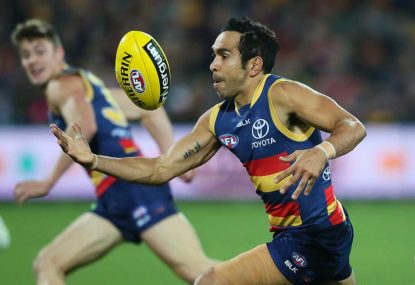The last five or six years will go down as a tumultuous time in Adelaide’s history.
Firstly, Neil Craig was sacked as coach in 2011, after taking the Crows to five finals series in a row but never progressing to a grand final.
Then Brenton Sanderson took over, catapulting Adelaide from bottom-four side to preliminary finalist in his first season, off the back of a favourable draw. His tenure was short-lived when they couldn’t sustain their football from that year.
Phil Walsh was appointed, and became a breath of fresh air for the competition, but was then tragically murdered mid-season at the hand of his own son. His vibrancy and passion for the game is missed to this day.
Don Pyke became senior coach for 2016, and allowed the Crows to play in Walsh’s spirit, with freedom and attacking instincts, while also shaping the team’s defensive pattern through the course of the year.
Adelaide has won elimination finals in the last two seasons, despite the upheaval and tragedy, but have failed to progress any further.
They will be confident of heading deeper into September this year.
| B |
Kyle Cheney |
Kyle Hartigan |
Luke Brown |
| HB |
Jake Lever |
Daniel Talia |
Rory Laird |
| C |
Brodie Smith |
Rory Sloane |
Rory Atkins |
| HF |
Tom Lynch |
Taylor Walker |
Mitch McGovern |
| F |
Eddie Betts |
Josh Jenkins |
Charlie Cameron |
| Foll |
Sam Jacobs |
Matt Crouch |
Brad Crouch |
| Int |
Scott Thompson |
Richard Douglas |
David Mackay |
Curtley Hampton |
Emergencies: Wayne Milera, Paul Seedsman, Riley Knight

Adelaide’s strength is in their forward-line. The 2483 points they scored in the home-and-away rounds in 2016 was the highest of any club, by a distance.
The Crows had four players kick 40 or more goals (Eddie Betts 75, Josh Jenkins 62, Taylor Walker 47 and Tom Lynch 42), plus Mitch McGovern with 32. They can all take a grab, they can all share the spoils, and we know how well they work together.
Jenkins plays the deepest, in what we might call the traditional full-forward role, except he’s also the supporting ruck. Betts is the size and shape of a traditional crumbing forward pocket, with a taste for the mercurial, but can also lead out from the square.
Walker, Lynch and McGovern are a unique combination in that they all have the height of centre-half-forwards, but the mobility of flankers. As a rule, Lynch plays the furthest up the ground, Walker slots in behind him, with McGovern behind both again.
It’s educational to observe their running patterns, and by effectively having three centre-half-forwards, no defence can possibly have a perfect match-up for them all.
Adelaide’s defence is set up similar to the forwards, with three genuine tall defenders (Daniel Talia, Jake Lever and Kyle Hartigan are all 195-197cm), plus Kyle Cheney who plays tall if required. Again, mobility is a feature of this line-up.
In last year’s Adelaide preview, I wrote that Talia needed to influence the play more, and he certainly did that, becoming a much more complete and damaging player in the process. It was his finest season, and he was a lock for his deserved All-Australian gong.
Rory Laird and Brodie Smith provide the run out of defence. Smith can pull off the types of kicks that few can, and is at his best when booming them on the fly. Laird is more precise with his disposal, and is the best half-back in the league at finding a teammate under pressure, when there is turmoil all around him.
If Don Pyke’s side has a weak point, it’s in the middle, which is not really where you want to be at your most fragile.
The Crows lost twice to Geelong last year, when they were unable to match the Cats for star power in the middle. The two teams who kicked the highest totals against them were Sydney and the Western Bulldogs – both of which are renowned for the quality and depth of their midfields.
Rory Sloane is a gun, but not quite in the very top echelon. Scott Thompson has been doing his thing since time immemorial, and it’s easy to forget that he actually started his career at Melbourne, under the tutelage of Norm Smith.
Matt Crouch took his game up a few levels last year, and will look to improve again. Brad Crouch has a more rounded game than his brother, but has had injury issues dog his career so far. Both are ball magnets.
Richard Douglas, Rory Atkins, and David Mackay provide support, but the entire midfield looks more limited than the other contenders. No wonder Bryce Gibbs was actively courted over the trade period, and surely will be again. Curtley Hampton could be the game-breaker they need if he can rejuvenate his stop-start career.
In summary, Adelaide has a potent best 22 – an incredibly talented and complementary attack, a strong back six, and a midfield that isn’t as deep as others yet, but can reach greater heights with the Crouch brothers on the rise.
What’s harder to judge is their depth. The Crows only used 29 players at senior level last year, a full 12 per cent less than any other side. The last club to use less than that in a season was Melbourne in 1959, who used 27. It was an historical anomaly.
In 2015, they used only 32 players, which was the equal least of any team that year.
We’ve seen Adelaide be able to adapt supremely to losing talent between seasons, regardless of who was at the helm. Nathan Bock and Phil Davis were poached by expansion. Patrick Dangerfield and Jack Gunston were traded for unders. Kurt Tippett walked out with no compensation given.
What we don’t know is how the Crows will fare if they lose multiple cogs out of any area of the ground in-season. Already, we’re seeing a number of injuries scattered across pre-season. Rory Sloane fractured a cheekbone, Brad Crouch did a hamstring, Scott Thompson has a shoulder. Cam Ellis-Yeolman, a handy depth player, is already out for the season. The tide is starting to turn against them.
Adelaide have been a very good side for two seasons now, and likely will be again. They have a defence that is hard to break down and a forward set up that is hard to contain.
They’ll be around a similar mark once more, but it’s hard to shake the feeling that their depth will finally be tested this year, and we don’t really know what we’re going to get.
Predicted ladder spread: fourth-eighth
Predicted finish: seventh
Best and fairest: Rory Sloane
Leading goalkicker: Eddie Betts
All-Australian potential: Eddie Betts, Rory Laird, Tom Lynch, Rory Sloane, Daniel Talia
Rising Star candidates: Jordan Galluci, Wayne Milera, Harrison Wigg
7th – Adelaide
8th – St Kilda
9th – Hawthorn
10th – Richmond
11th – Collingwood
12th – Gold Coast
13th – Port Adelaide
14th – Fremantle
15th – Essendon
16th – North Melbourne
17th – Carlton
18th – Brisbane






























































































